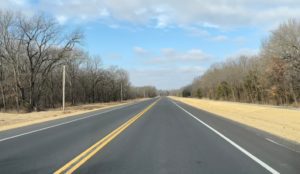Glitch discovered in material; Closures likely early summer


“Essentially, the contractor discovered that somehow a substantial amount of shale was present in the top lift of asphalt and brought this to our attention,” said Siemers. “This became visible once traffic had been on the road for a month or so. The shale isn’t as strong as limestone which is what the aggregate in asphalt is supposed to consist of, and it became clear that there was an issue when the shale particles started fragmenting and breaking at the surface.”
Siemers said the specification allows for a very small amount of shale or other “deleterious” materials to be present in the paving, but “this appeared to exceed what could be considered acceptable.”
“Unfortunately, the material testing methods we employ would not catch this,” Siemers said. “We test for density, air voids, gradation, and compaction, but we don’t actually test the makeup of the aggregate, which is certified by the materials supplier as part of their asphalt mix design. We are fortunate that we are working with a great contractor who identified the deficiency and stepped up immediately to help us find a fix for it.”
“The issue became visible in the form of what appeared to be streaks on the pavement when it rained a few weeks after the asphalt had been opened up to traffic. The streaking identified by the contractor basically revealed that some of the aggregate at the surface of the roadway had fractured once exposed to traffic, and the now-exposed particles of shale were ‘bleeding’ when exposed to the rainfall. We followed up with our testing lab to come up with a way to quantify how much shale made its way into the mix and compare those results with what the specifications allow, and the results exceeded what is permissible.”
Siemers said asphalt is laid in “lifts,” and that Hillcrest was built with two three-inch-thick lifts of a coarse asphalt mix called a base course and one two-inch-thick lift of a finer asphalt mix called a surface course.
“We tested all three lifts and, fortunately, the shale is isolated to the top two-inch lift, so we can replace that rather than all of the asphalt,” he said. “We are currently working with the contractor and the supplier to replace these materials and go back in and mill off the top two inches of the roadway and re-lay it with asphalt that meets the specifications.
“This is part of the process on our projects. We provide a specification for the work and if the workmanship or materials don’t meet the specifications, sometimes they have to be redone. In this case, it was just a bad batch of asphalt and out of the contractor’s control. It is unfortunate, but it has to be done to ensure our taxpayers are getting what they paid for.”
No additional taxpayer cost is involved in the reconstruction.
“The cost of the materials and labor will be decided between the supplier and the contractor,” he said.
Siemers said the project is likely to begin in June.
“We’re targeting early summer for this to avoid closing the road while the nearby Bartlesville High School is still in session,” Siemers said. “That will help reduce traffic congestion in the detour areas and will be generally better for all concerned.”
Siemers said while partial closures are an option in these types of projects, closing the road completely to allow contract crews maximum work time will shorten the overall project considerably.
“We anticipate total closure of the roadway will allow the entire project to take two to three weeks, if that,” he said. “We understand this is an inconvenience, but we believe it’s the best way to remedy the situation with the least interruption.”
Siemers said the faulty material does not pose an immediate safety issue but could result in the road deteriorating before it otherwise would.
“It could affect the quality of the roadway over time,” he said. “We don’t know that for certain, but there is a reason the materials are designed the way they are, and it’s best to take care of this now to ensure the long-term safety and overall life-span of the road.”
Detours will be in place to reroute traffic just west of the roundabout at Silver Lake Road and Price Road and on Shawnee Avenue near Bartlesville High School.
The $2.2 million project, approved by voters in the 2013 Half-cent Capital Improvement Projects Election, involved reconstructing Hillcrest Drive from the Caney River to just north of 20th Street. The new roadway consists of two 12-foot-wide drive lanes with six-foot-wide asphalt shoulders. Turn lanes were added at Shawnee Avenue and 20th Street, and a pedestrian path in the area was constructed by maintaining some of the existing roadway.
